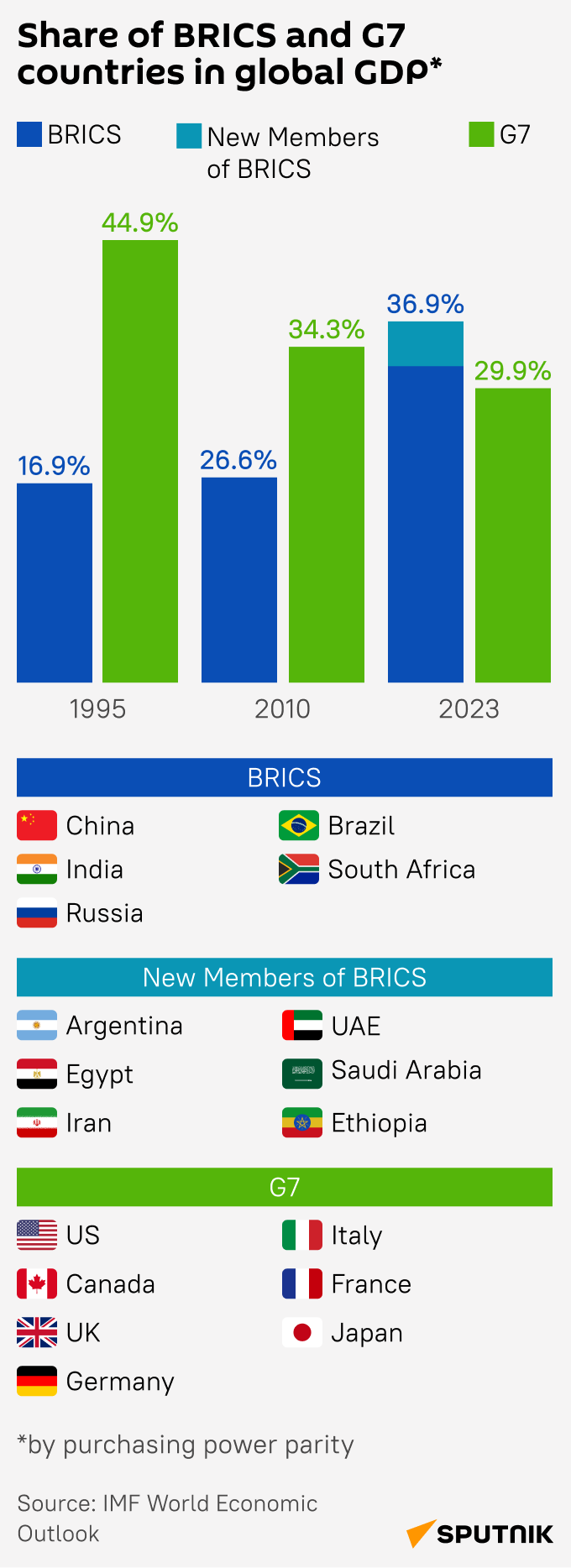https://sputnikglobe.com/20230826/how-do-brics-stack-up-against-g7-1112913972.html
How Do BRICS Stack Up Against G7?
How Do BRICS Stack Up Against G7?
Sputnik International
BRICS announced a historic expansion of its membership this week, incorporating six new countries into the bloc. How do BRICS economies compare to the G7 group of wealthy industrialized nations?
2023-08-26T18:35+0000
2023-08-26T18:35+0000
2023-08-26T18:35+0000
multimedia
south africa
brics
g7
the united nations (un)
summit
brics summit 2023
https://cdn1.img.sputnikglobe.com/img/07e7/08/1a/1112913807_0:0:2560:1440_1920x0_80_0_0_c4e11439e2be1142abbeb2787639a056.png
The BRICS group's membership more than doubled at the bloc's summit in Johannesburg, South Africa on Thursday, incorporating Argentina, Egypt, Ethiopia, Iran, Saudi Arabia and the United Arab Emirates.The original BRIC bloc, consisting of Brazil, Russia, India, China, was created in 2009 after years of negotiations, to facilitate economic cooperation and joint investment opportunities, global development, UN reform, and providing developing countries with a greater voice and representation in international financial institutions. South Africa joined the bloc in 2010, creating BRICS.The acronym BRIC was coined by Goldman Sachs economist Jim O'Neill in 2001 to highlight the group of developing economies he predicted would exceed the combined economic power of the developed West by the year 2050.But the economist may have underestimated the pace of the BRICS bloc's rise, with the five nation bloc officially overtaking the G7's share of global gross domestic product (GDP) in purchasing power parity (PPP) terms earlier this year. With the addition of six new members, the expanded BRICS now account for almost 37 percent of the global economy, compared with about 30 percent for the G7 nations, which include the US, Canada, Britain, Germany, Italy, France and Japan.With South African officials revealing that over 40 nations have expressed interest in joining the economic super bloc, and member nations' economic growth continuing to surge relative to the G7, O'Neill's predictions might need a bit of a touch up.Check out Sputnik's infographic to find out how BRICS stacks up against the G7.
south africa
Sputnik International
feedback@sputniknews.com
+74956456601
MIA „Rossiya Segodnya“
2023
Sputnik International
feedback@sputniknews.com
+74956456601
MIA „Rossiya Segodnya“
News
en_EN
Sputnik International
feedback@sputniknews.com
+74956456601
MIA „Rossiya Segodnya“
Sputnik International
feedback@sputniknews.com
+74956456601
MIA „Rossiya Segodnya“
brics, expansion, g7, chart, economic weight, economic power, world economy, gross domestic product, purchasing power parity
brics, expansion, g7, chart, economic weight, economic power, world economy, gross domestic product, purchasing power parity
How Do BRICS Stack Up Against G7?
BRICS announced a historic expansion of its membership this week, incorporating six new countries into the bloc. How do BRICS economies compare to the G7 group of wealthy industrialized nations?
The BRICS group's membership more than doubled at the bloc's summit in Johannesburg, South Africa on Thursday, incorporating Argentina, Egypt, Ethiopia, Iran, Saudi Arabia and the United Arab Emirates.
The original BRIC bloc, consisting of Brazil, Russia, India, China, was created in 2009 after years of negotiations, to facilitate economic cooperation and joint investment opportunities, global development, UN reform, and providing developing countries with a greater voice and representation in international financial institutions. South Africa joined the bloc in 2010, creating BRICS.
The acronym BRIC was
coined by Goldman Sachs economist Jim O'Neill in 2001 to highlight the group of developing economies he predicted would
exceed the combined economic power of the developed West by the year 2050.But the economist may have underestimated the pace of the BRICS bloc's rise, with the five nation bloc officially overtaking the G7's share of global gross domestic product (GDP) in purchasing power parity (PPP) terms earlier this year. With the addition of six new members, the expanded BRICS now account for almost 37 percent of the global economy, compared with about 30 percent for the G7 nations, which include the US, Canada, Britain, Germany, Italy, France and Japan.
With South African officials revealing that over 40 nations have expressed interest in joining the economic super bloc, and member nations' economic growth continuing to surge relative to the G7, O'Neill's predictions might need a bit of a touch up.
Check out Sputnik's infographic to find out how BRICS stacks up against the G7.



